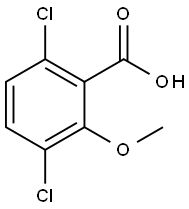1918-00-9

Product Name:
Dicamba
Formula:
C8H6Cl2O3
Synonyms:
3,6-Dichloro-o-anisic acid;3,6-Dichloro-2-methoxybenzoic acid
Inquiry
CHEMICAL AND PHYSICAL PROPERTIES
| Physical Description | Dicamba is a white solid dissolved in a liquid carrier. The carrier is water emulsifiable. The primary hazard is the threat to the environment. Immediate steps should be taken to limit its spread to the environment. Since it is a liquid it can easily penetrate the soil and contaminate groundwater and nearby streams. It can cause illness by inhalation, skin absorption and/or ingestion. It is used as a herbicide. |
|---|---|
| Color/Form | Crystals from pentane |
| Odor | Odorless (reference grade) |
| Boiling Point | > 200 °C |
| Melting Point | 237.2 to 240.8 °F (USCG, 1999) |
| Flash Point | Not Applicable. Not flammable. (USCG, 1999) |
| Solubility | In water, 8310 mg/L at 25 °C |
| Density | 1.57 g/cu cm at 25 °C |
| Vapor Density | 7.62 (USCG, 1999) - Heavier than air; will sink (Relative to Air) |
| Vapor Pressure | 0.0000338 [mmHg] |
| LogP | log Kow = 2.21 |
| Stability/Shelf Life | Stable under recommended storage conditions. |
| Autoignition Temperature | Not Applicable. Not flammable. (USCG, 1999) |
| Decomposition | When heated to decomposition it emits toxic fumes of /chlorine/. |
| Corrosivity | Mild to noncorrosive |
| Odor Threshold | /SRP: Air/ 250.8 PPM |
| Dissociation Constants | pKa = 1.97 |
| Collision Cross Section | 157.21 Ų [M+Na]+ [CCS Type: DT, Method: stepped-field] |
| Kovats Retention Index | 1617 1657.6 |
| Other Experimental Properties | At 200 °C dicamba is decarboxylated to give 2,5-dichloroanisole |
| Chemical Classes | Pesticides -> Herbicides, Chlorophenoxy |
SAFETY INFORMATION
| Signal word | Danger |
|---|---|
| Pictogram(s) |
 Corrosion Corrosives GHS05  Exclamation Mark Irritant GHS07 |
| GHS Hazard Statements |
H302:Acute toxicity,oral H318:Serious eye damage/eye irritation H412:Hazardous to the aquatic environment, long-term hazard |
| Precautionary Statement Codes |
P264:Wash hands thoroughly after handling. P264:Wash skin thouroughly after handling. P270:Do not eat, drink or smoke when using this product. P273:Avoid release to the environment. P280:Wear protective gloves/protective clothing/eye protection/face protection. P301+P312:IF SWALLOWED: call a POISON CENTER or doctor/physician IF you feel unwell. P305+P351+P338:IF IN EYES: Rinse cautiously with water for several minutes. Remove contact lenses, if present and easy to do. Continuerinsing. |
COMPUTED DESCRIPTORS
| Molecular Weight | 221.03 g/mol |
|---|---|
| XLogP3 | 2.2 |
| Hydrogen Bond Donor Count | 1 |
| Hydrogen Bond Acceptor Count | 3 |
| Rotatable Bond Count | 2 |
| Exact Mass | 219.9693994 g/mol |
| Monoisotopic Mass | 219.9693994 g/mol |
| Topological Polar Surface Area | 46.5 Ų |
| Heavy Atom Count | 13 |
| Formal Charge | 0 |
| Complexity | 198 |
| Isotope Atom Count | 0 |
| Defined Atom Stereocenter Count | 0 |
| Undefined Atom Stereocenter Count | 0 |
| Defined Bond Stereocenter Count | 0 |
| Undefined Bond Stereocenter Count | 0 |
| Covalently-Bonded Unit Count | 1 |
| Compound Is Canonicalized | Yes |
PRODUCT INTRODUCTION
description
Dicamba is a white solid dissolved in a liquid carrier. The carrier is water emulsifiable. The primary hazard is the threat to the environment. Immediate steps should be taken to limit its spread to the environment. Since it is a liquid it can easily penetrate the soil and contaminate groundwater and nearby streams. It can cause illness by inhalation, skin absorption and/or ingestion. It is used as a herbicide.